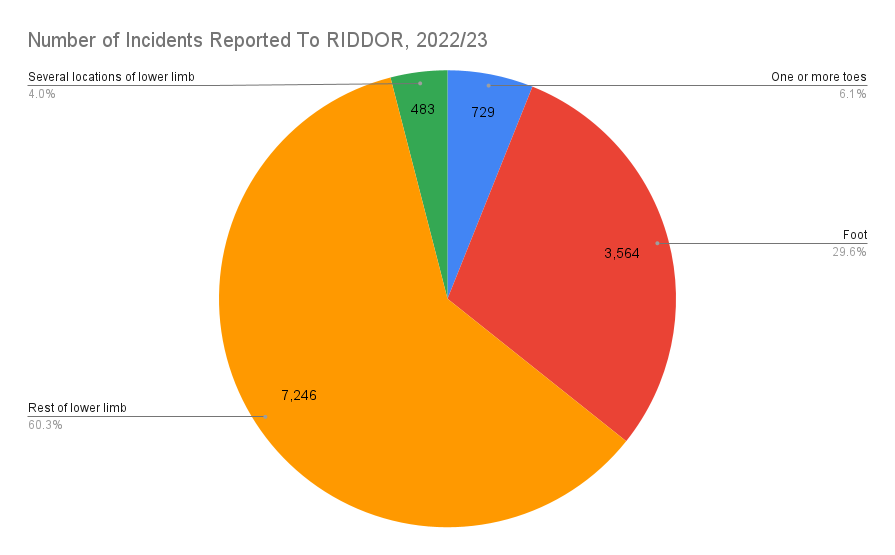Following an accident in the workplace where you have suffered a broken toe, you may be entitled to begin a personal injury claim. Our guide examines who could be eligible to claim broken toe at work compensation after their employer breached their duty of care and caused an accident.
Within this guide, we have explained the duty of care all employers owe their employees and some examples of workplace accidents that could cause you to suffer a toe or foot injury if this duty is breached.
You will also find information on how injury at work compensation is calculated and the two different heads of claim that could be awarded to form your final settlement. The final section of this guide discusses the various benefits of instructing a personal injury solicitor from our expert panel to represent you on a No Win No Fee basis.
Get in touch with our friendly and dedicated advisors at any time for free advice regarding your case. They can also help answer any questions you might have regarding the toe injury compensation claims process. Our team are available 24 hours a day via the following contact details:
- Phone on 020 8050 2736.
- Start a claim online by completing this form.
- Ask a question using our live chat.

Select a Section
- When Can You Claim Broken Toe At Work Compensation?
- What Are Common Causes Of A Broken Toe At Work?
- How Much Compensation For A Broken Toe At Work?
- What Evidence Can Support A Broken Toe Compensation Claim?
- How Could You Make A No Win No Fee Broken Toe Compensation Claim?
- More Resources About Claiming Broken Toe At Work Compensation
When Can You Claim Broken Toe At Work Compensation?
Employers are legally obliged to keep their workers safe while they are performing their work activities. This duty of care is set out in the Health and Safety at Work etc. Act 1974. Per the legislation, employers must take reasonable steps to ensure the safety of their staff. If this duty is not met, you could suffer a toe injury in a workplace accident.
In order to have a valid broken toe at work compensation claim, you will need to show the following:
- Your employer owed you a duty of care at the time of the accident.
- The employer breached this duty of care.
- This breach resulted in an accident during which you suffered a broken toe.
Is There A Time Limit When Claiming Broken Toe At Work Compensation?
Personal injury claims are usually subject to a limitation period of 3 years from the date of the accident, as established by the Limitation Act 1980. In certain circumstances, however, exceptions to this could be granted. These exceptions apply to:
- Injured persons who are under the age of 18.
- Those lacking sufficient mental capacity to handle their own legal proceedings.
Talk to one of our advisors today to learn more about the personal injury claims time limit and the exceptions that apply. They can also inform you whether you may have a valid toe injury compensation claim.
What Are Common Causes Of A Broken Toe At Work?
There are an array of circumstances where you could suffer a foot or toe injury in the workplace. However, you must remember that in order to be able to make a claim for broken toe at work compensation, your injury must have been caused by your employer failing to adhere to their duty of care.
Examples of workplace accidents that could cause you to suffer a toe injury include:
- Your employer failed to provide you with adequate protective footwear while working on a construction site. Due to this, you suffer multiple toe fractures when some construction equipment, such as bricks, fall onto your foot.
- Your employer failed to repair the breaks on a faulty forklift. Despite this, they still asked your colleague to operate the vehicle. Due to the faulty breaks, your colleague was unable to stop the forklift in time, causing them to run over your foot. You suffer a severe crush injury to all of your toes.
- Your employer had not provided you with sufficient manual handling training. Consequently, you attempted to lift a box with an improper technique, dropped the box onto your foot, and broke your toe.
These are only a few examples of workplace accidents that may lead to toe injury claims. For further guidance on when you could be eligible to claim compensation for a broken toe at work, contact our advisors today using the details given below.
What Are The Symptoms Of A Broken Toe?
According to the NHS, some possible symptoms of a broken toe include redness and swelling, bruising and pain. You may also have difficulty walking. It can be difficult to tell if your toe is broken or simply bruised without seeking medical treatment.
If you suspect your big toe is broken, the toe is pointing at an odd angle, or you can see bone protruding, the NHS states you should go to A&E or call an ambulance if you are unable to get there by yourself.
If your employer’s failure to uphold its duty of care caused you to suffer the break or suspected break, contact our team today to find out if you could claim compensation.
How Much Compensation For A Broken Toe At Work?
Compensation in successful accident at work claims can be awarded under two different heads of claim. The pain and suffering caused by your injuries are compensated under general damages. This head of claim is awarded to all successful claimants.
Those in charge of valuing your claim for general damages may use any medical evidence you provided alongside the Judicial College Guidelines (JCG).
The JCG sets out the guideline compensation brackets for various types of injuries. We have used a selection of these figures in the table here. It is important we emphasise that the top table entry was not taken from the JCG and that this table should only be referred to as a guide.
Compensation Table
| Type of Injury | Severity | Guideline Compensation Value | Notes |
|---|---|---|---|
| Multiple Very Serious Injuries in addition to Monetary Losses. | Very Serious | Up to £150,000+ | Compensation for multiple very serious injuries as well a loss of earnings, medical bills and other special damages payments. |
| Toe Injuries | Amputation of All Toes (a) | £36,520 to £56,080 | Award within this bracket are influenced by whether or not the amputation was surgical or traumatic, as well the extent of forefoot loss and resulting mobility issues. |
| Amputation of the Great Toe (b) | In the region of £31,310 | Loss of the great toe on one foot. | |
| Severe (c) | £13,740 to £21,070 | Severe crush injuries, bursting wounds and other injuries that lead to the loss of one or two toes (excluding the great toe) or injuries that fall short of amputation or only require partial amputation. | |
| Serious (d) | £9,600 to £13,740 | Serious Great toe injuries or cases where there have been multiple fractures to at least 2 toes. | |
| Moderate (e) | Up to £9,600 | Non-complex fractures or laceration injuries to one or more toes. | |
| Foot Injuries | Serious (e) | £24,990 to £39,200 | Less severe injuries that lead to continuing arthritic pain or the risk of future arthritis and fusion surgery. |
| Modest (g) | Up to £13,740 | Simple metatarsal fractures, puncture wounds, ligament damage or similar injuries that result in a continuing limp, aching or pain. |
Special Damages
Special damages is the second of the head of claim that could form your broken toe at work compensation settlement. Any monetary losses you have experienced due to your injuries could be compensated under this. Some examples of financial losses that could be reimbursed under special damages include:
- You may entitled to loss of earnings payments if your injuries meant you needed to take time off work.
- The cost of public transport to and from work or medical appointments could be reimbursed as part of your compensation.
- The cost of in-home care and support with various daily tasks such as meal preparations and cleaning if you cannot do these by yourself safely.
- Prescription medicines, therapy sessions or other medical bills that need to be paid out of pocket.
When claiming special damages, evidence such as payslips, receipts, and invoices should be presented to prove these financial losses.
Broken Toe At Work Statistics
According to reports made by employers under the Reporting of Injuries, Diseases and Dangerous Occurrences Regulations 2013 (RIDDOR), 60,645 non-fatal injuries were suffered by employees between 2022 and 2023.
Of those non-fatal injuries, 17,738 were injuries to lower limbs, with 729 injuries to one or more toes, and 3,564 injuries suffered to the foot. Some of these injuries may have included sprains, fractures or crush injuries.
To see whether you could be eligible to claim toe injury compensation for your foot and toe injury, you can contact a member of our advisory team today. They can also offer you a free valuation of your case.
What Evidence Can Support A Broken Toe Compensation Claim?
In this section, we highlight what evidence is needed for a personal injury claim. Gathering supporting evidence is an important step in the claiming process as it can help with proving how your employer was liable and the severity of the injuries you suffered.
Some examples of evidence that could be used for a broken toe at work compensation claim include:
- Medical evidence of your injuries. This could include X-rays and your medical records highlighting the treatment you have received for said injuries.
- A copy of your accident report from the workplace accident book. This could provide information on when and how the accident occurred.
- Any video footage, such as CCTV, of the accident taking place.
- You can also take photographs of your injuries and the accident scene.
- The contact information of anyone who saw your accident and could provide a statement later into the claiming process.
Other evidence may be available to you depending on your circumstances. For free advice on the evidence you could collect or to get an assessment of your eligibility to claim, contact our team today using the details given below.
How Could You Make A No Win No Fee Broken Toe Compensation Claim?
Contact our advisors to learn if you are eligible to make a broken toe at work compensation claim. If they deem you to have a strong case, they could connect you with an expert personal injury solicitor on our panel.
The solicitors on our panel usually offer their services under a Conditional Fee Agreement (CFA). A CFA is a type of No Win No Fee contract that provides claimants with various benefits. For example, there will be no fee to pay to your solicitor for them to begin working on your claim, nor will you have to pay them for their continued services during the process of your claim. There will also be no fee to pay for their work should the claim fail.
A successful accident at work claim will see you awarded compensation. Your solicitor will deduct a success fee from this compensation. The law implements a legal limit for the percentage that can be taken as this fee.
Contact Us About Your Toe Injury Claim
To discuss your broken toe at work compensation claim, you can contact our advisors. As well as offering you free advice, they could help answer your questions about the claiming process and potentially connect you with one of the solicitors on our panel.
Contact our team today via the following methods:
- Phone on 020 8050 2736.
- Start a claim online by completing this form.
- Ask a question using our live chat.
More Resources About Claiming Broken Toe At Work Compensation
See some of our other accident at work claims guides by following these links:
- Read our guide on what your potential claim after a fall at work could be worth.
- Learn about your rights after you had an accident at work with this guide.
- Broken toes could occur after slips, trips and falls in the workplace, read more on this type of claim here.
We have also provided these external resources for additional information:
- Read the NHS guidance on when to call 999 on their website.
- You can learn about the different types of reportable incidents with this resource from the HSE.
- Following a workplace accident, you may be entitled to Statutory Sick Pay. You can find out more on the Government website.
To discuss your potential broken toe at work compensation claim you can contact an advisor from our team.


